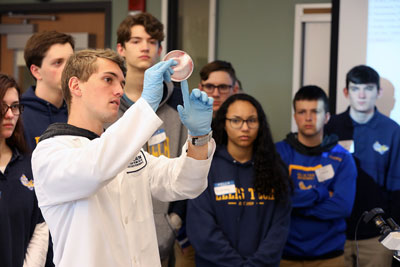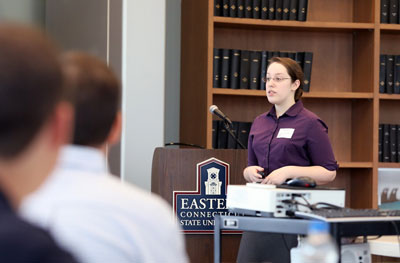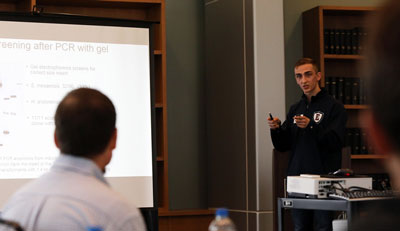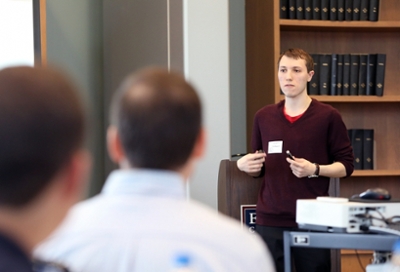- Apply
- Visit
- Request Info
- Give
Bio Department Hosts ‘Tiny Earth Day,’ Welcomes Local High School
Written by Michael Rouleau
Published on April 26, 2019

The Biology Department hosted a mini-symposium on Earth Day, April 22, to showcase its ongoing work with the Tiny Earth project, an international network of young scientists who are combatting the global threat of antibiotic resistance. The symposium welcomed students from Ellis Technical High School in Danielson and featured research presentations by biology majors.
The United Nations has named antibiotic resistance a global priority. Antibiotics are used to treat bacterial infections such as pneumonia. However, as antibiotics are misused – and new ones are slowly discovered – harmful bacteria develop resistances against them, rendering the medications ineffective.
An estimated 25,000 people in the United States die from antibiotic-resistant bacteria every year, with an approximate 700,000 annual deaths worldwide. Researchers predict the death toll to rise to 10 million per year by 2050.
Through Professor Jonathan Hulvey’s General Microbiology class, Eastern students have joined scientists worldwide in the pursuit of new antibiotics by examining microorganisms found in soil. Why soil? Many of the most commonly prescribed antibiotics were discovered from “dirt,” including penicillin and vancomycin.
Highschool students from Ellis Tech have assisted in the effort by providing soil samples from locations across their high school campus. To date, Eastern students have cultured more than 60 antibiotic-producing bacteria from Ellis Tech as well as Eastern’s Church Farm property in Ashford. Hulvey and students are working on biochemical and genetic characterization of the bacteria before sending them to the Tiny Earth headquarters at the University of Wisconsin-Madison.
“Eastern students are carrying out research to tackle the global problem of antibiotic resistance,” said Hulvey, “and this discovery-based learning approach has been an exciting and engaging framework for imparting marketable microbiology skills. Over the course of the semester, my students have worked on these soil samples, and their grasp of the techniques was on display during their lab demonstrations for the Ellis Tech students.”
The Ellis Tech participants are from the honors biology class of teacher Brooke DiFormato, a 2007 Eastern graduate. She mentioned how technical high school students are often expected to go into the trades, but this experience—and the experience of visiting Eastern—has shown some of her students that college is an option.
The event featured presentations by three biology majors. Stefanos Stravoravdis presented on fungicide resistance—a research interest of Hulvey’s with many parallels to antibiotic resistance. Lauren Atkinson presented on the scorpion microbiome, an ancient lineage (450 million years old) of microorganisms that has been exposed to many pathogens over the ages and likely contains antibiotic-producing bacteria. Chris Shimwell’s research has investigated the molecular ID of the scorpion telson microbiome — the telson is the segment of the tail nearest to the stinger.
The student-sourcing approach of Tiny Earth was first brought to Eastern’s campus in 2013 by Biology Professor Barbara Murdoch, who piloted the program via independent study. “I wanted to link my research to a larger global problem,” she said, “and to enhance the critical thinking, research and communication skills of our students.”
The goals of Tiny Earth include increasing public awareness of the antibiotic-resistance crisis, inspiring students to pursue careers in the sciences, and engaging them in the global priority of discovering new antibiotics. The program started in 2013 and now utilizes more than 10,000 students from 41 states and 14 countries.





